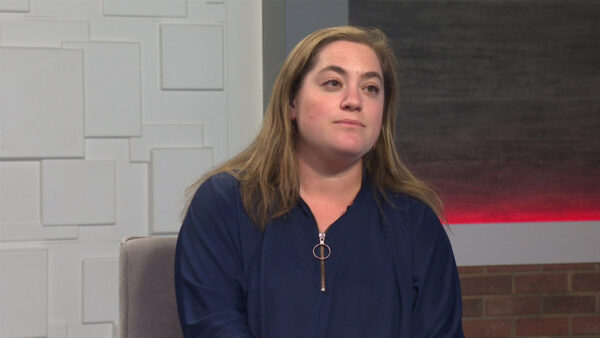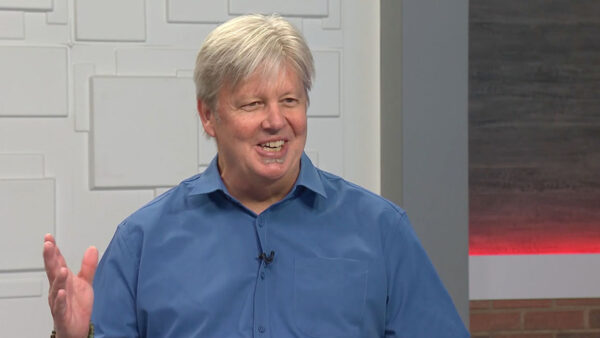Kenny Barrett, artist and Project Manager for Roosevelt Row Community Development Corporation and Braden Kay of ASU’s Global Institute of Sustainability, talk about the benefits of a collaborative effort between the Roosevelt Row CDC and Phoenix Union Bioscience High School to grow sunflowers on a vacant lot in downtown Phoenix.
Ted Simons: A vacant city block in downtown Phoenix is being transformed into a two-acre field of sunflowers. It's an effort to beautify the area while producing a useful product. I'll talk with project leaders in a moment, but first, David Majure takes us to sixth Street and Garfield where the growing has begun.
David Majure: This is valley of the sunflowers. It don't look like much now, but give it time. With hard work, water, sun, and patience, the dull dusty brown of this vacant lot will be replaced by a canvas of yellow and green.
Kenny Barrett: So everybody over here, let's go to the white truck. We can get all the rakes out of the back of the truck.
David Majure: The Roosevelt Row Community Development Corporation is leading the effort.
Kenny Barrett: Before you go, grab some gloves on your left.
David Majure: It's turning two acres of dirt into a productive field of sunflowers.
Kenny Barrett: You know, this is our first season. This is really our experimental season. Basically the project is to plant two acres of sunflowers on a vacant lot, and then grow the flowers until they bloom, let them start to dry, we'll harvest them, and then we will take the seeds and we'll press them for oil and then we're going to take the soil and give it back to the bioscience high school, and the kids who are already producing and making biofuel are going to create biofuel from the oil.
David Majure: The project launched with a groundbreaking September 9th, since then, volunteers have been busy preparing the soil. Installing a sprinkler system. And just this week, students from Phoenix union's bioscience high school planted the very first seeds.
Kenny Barrett: We're going to be planting at least 60,000 seeds, probably. That's the plan. Two seeds for each hole.
David Majure: If all goes as planned, by January 2012, the first crop of sunflowers will be ready for harvest.
Ted Simons: Joining me to talk about the Valley of the Sunflowers project is Kenny Barrett, artist and project manager for Roosevelt Row Community Development Corporation, and Braden Kay of ASU's global institute of sustainability. Good to have you both on the show. Thanks for joining us. How did all this get started? I remember you were growing sunflowers on a corner, and now we've got a two-acre lot.
Kenny Barrett: Well, right across the street from the sunflowers project is the community garden called the grow house. And we really start there'd about three weeks ago. Myself and another artist. And we started small W. three beds and it grew and grew, and along the property line we would grow sunflowers as more after functional thing in the beginning to keep people out of the garden beds. Certain times of the year as you're walking doubt sidewalks you look at the sunflowers and you look farther and you see all these vacant lots everywhere. And it was really putting two and two together. The growing the sunflowers for functionality, and then being inspired by the empty space across the street.
Ted Simons: And then taking the sunflower seeds and pressing them into biofuel?
Braden Kay: Yeah. So we're going to press the seeds and then they've already at bioscience they have a very creative curriculum that is project based, and one of the things the sophomore biochemistry class had already been doing is taking oil and creating biodiesel. We realized we could make oil out of the sunflower seeds, turn that into biodiesel and that will fuel a biodiesel solar powered hybrid car that the engineering students and the E-tech club students been working on for several years.
Ted Simons: This is Phoenix union bioscience high school students.
Braden Kay: Exactly. So this lot is situated between grow house, which is a project of Roosevelt Row Community Development Corporation, and bioscience high school on the Phoenix biomedical campus. So all of this land is slated to be the future of Phoenix's biomedical businesses and projects. And so the idea is that they created a high school, the Phoenix union was really forward thinking, and they create add high school to fuel the students that we're going -- that were going to become the workers of the bioscience economy.
Ted Simons: The high school association, is that why this land was chosen? A lot of vacant lots down there. Why this one?
Kenny Barrett: Absolutely. The proximity to the high school was a huge factor. Being right between the grow house community garden and the bioscience, it was perfect.
Ted Simons: So who technically owns that land?
Kenny Barrett: It's city of Phoenix property. And it's going to be like Brian mentioned, part of the biomedical campus in the future. So this project is temporary based, it's two seasons, and after the spring, it will maybe be used for construction staging and eventually will become part of the biomedical campus.
Ted Simons: And how is all this being funded?
Kenny Barrett: Well, that's a great question. This was a big idea not too long ago, and one of our Buddies from the community who lives in the neighborhood, Sean sweat, he came out to our first art program volunteer day, and art is the adaptive reuse of temporary space, he came out to the first day and he said, you know, I think we have grant for this at Intel where I work. So let me hear more, we said. And he came back with this sustainability in action program they have at Intel to get their employees out into the community as really being leaders in the science and technology with the students in education.
Ted Simons: When we're talking about biofuel and we're talking about pressing this into a new form of energy, at what point, what kind of cost dynamics, are we looking at here?
Braden Kay: At the end of the day what we're trying to do is create an experience education for bioscience students to see the seed to engine project. But this is not financially viable for growing -- Phoenix isn't going to have sunflowers across the city of Phoenix. This is supposed to be a catalyst for conversations about, what should the future look like for energy, for transportation, for education in Phoenix, and here have you some really creative partners between Intel and the bioscience high school and Roosevelt row, and ASU coming together to be like, we're going to take this lot and use it as an opportunity to have conversations about tomorrow.
Ted Simons: And it also beautifies the area. It's nice to look at a bunch of sunflowers.
Kenny Barrett: Yeah, absolutely. That was a huge factor. That was one thing I didn't mention, when people would walk by the garden, the community garden, they would always comment on the flowers. And here we are slaving, growing these vegetables, and the flowers would always be the topic of conversation. And so it became this point of inspiration, and we identified that, and that's another reason we wanted to activate the field with flowers.
Ted Simons: Talk about if you would this adaptive use of temporary spaces, art program. What are we dealing with here?
Braden Kay: Basically it's about taking vacant lots that exist in Phoenix and creating opportunities. So we've come up with a variety of ways to use these lots as an asset opposed to something that gets in the way of us creating a more economically vibrant city.
Ted Simons: If the owner or whoever owns a lot comes backs and says, I think I want to build here, sunflowers have got to go.
Kenny Barrett: That is the end goal. This program is just a temporary project program. We're basically activating the lots in the interim that temporary period before they get developed. And development is the end goal. And that's what we want to see, a dense urban, you know, walkable community.
Braden Kay: As we're talking about in terms of sustainability, and what we want to do with downtown Phoenix, this is an opportunity for us to have important conversations and make steps right now with the property we have as it stands. Obviously we want the businesses of the future on this property, we want long-term permanent building, but for now we're going to be inspired by sunflowers.
Ted Simons: Instead after pop-up gallery, a pop-up farm field. Gentlemen, congratulations. Good luck to you. Happy harvest. Have a good one.
Braden Kay: Thank you very much.
Kenny Barrett:Artist and Project Manager for Roosevelt Row Community Development Corporation, Braden Kay:ASU's Global Institute of Sustainability























